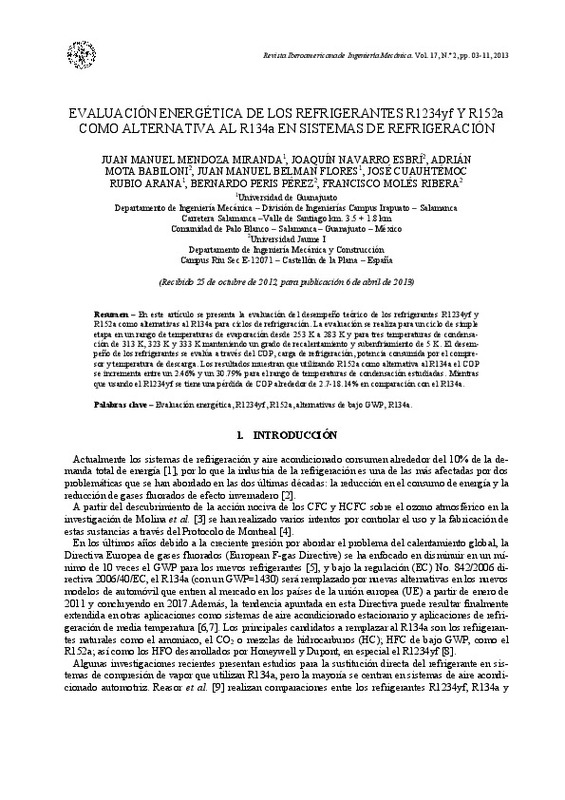JavaScript is disabled for your browser. Some features of this site may not work without it.
Buscar en RiuNet
Listar
Mi cuenta
Estadísticas
Ayuda RiuNet
Admin. UPV
Evaluación energética de los refrigerantes R1234yf y R152a como alternativa al R134a en sistemas de refrigeración
Mostrar el registro sencillo del ítem
Ficheros en el ítem
| dc.contributor.author | Mendoza Miranda, Juan Manuel
|
es_ES |
| dc.contributor.author | Navarro Esbri, Joaquin
|
es_ES |
| dc.contributor.author | Mota Babiloni, Adrián
|
es_ES |
| dc.contributor.author | Belman Flores, Juan Manuel
|
es_ES |
| dc.contributor.author | Rubio Arana, José Cuauhtémoc
|
es_ES |
| dc.contributor.author | Peris Pérez, Bernardo
|
es_ES |
| dc.contributor.author | Molés Ribera, Francisco
|
es_ES |
| dc.date.accessioned | 2015-12-15T08:11:57Z | |
| dc.date.available | 2015-12-15T08:11:57Z | |
| dc.date.issued | 2013-10 | |
| dc.identifier.issn | 1137-2729 | |
| dc.identifier.uri | http://hdl.handle.net/10251/58806 | |
| dc.description.abstract | [EN] This paper presents a theoretical performance of R1234yf and R152a as possible replacements of R134a in refrigeration systems. The refrigeration system performance using R134a, R1234yf and R152a was carried out for single stage refrigeration system for different evaporating condition ranging from 253 to 283 K and for condensing temperatures of 313 K, 323 K and 333 K holding 5 K as superheating degree and subcooling degree. Refrigerant performance is evaluated using COP, cooling capacity, power consumption and compressor discharge temperature. Results shown that COP increases about 2.47-30.79% using R152a, meanwhile COP decreases about 2.7-18.14% using R1234yf respect to R134a for the condensation and evaporation range studied. | es_ES |
| dc.description.abstract | [ES] En este artículo se presenta la evaluación del desempeño teórico de los refrigerantes R1234yf y R152a como alternativas al R134a para ciclos de refrigeración. La evaluación se realiza para un ciclo de simple etapa en un rango de temperaturas de evaporación desde 253 K a 283 K y para tres temperaturas de condensación de 313 K, 323 K y 333 K manteniendo un grado de recalentamiento y subenfriamiento de 5 K. El desempeño de los refrigerantes se evalúa a través del COP, carga de refrigeración, potencia consumida por el compresor y temperatura de descarga. Los resultados muestran que utilizando R152a como alternativa al R134a el COP se incrementa entre un 2.46% y un 30.79% para el rango de temperaturas de condensación estudiadas. Mientras que usando el R1234yf se tiene una pérdida de COP alrededor de 2.7-18.14% en comparación con el R134a. | es_ES |
| dc.language | Español | es_ES |
| dc.publisher | Universidad Nacional de Educación a Distancia (UNED) | es_ES |
| dc.relation.ispartof | Revista Iberoamericana de Ingeniería Mecánica | es_ES |
| dc.rights | Reconocimiento (by) | es_ES |
| dc.subject | Evaluación energética | es_ES |
| dc.subject | R1234yf | es_ES |
| dc.subject | R152a | es_ES |
| dc.subject | Alternativas de bajo GWP | es_ES |
| dc.subject | R134a | es_ES |
| dc.subject | Energy Evaluation | es_ES |
| dc.subject | Low GWP alternatives | es_ES |
| dc.title | Evaluación energética de los refrigerantes R1234yf y R152a como alternativa al R134a en sistemas de refrigeración | es_ES |
| dc.type | Artículo | es_ES |
| dc.rights.accessRights | Abierto | es_ES |
| dc.contributor.affiliation | Universitat Politècnica de València. Instituto de Ingeniería Energética - Institut d'Enginyeria Energètica | es_ES |
| dc.description.bibliographicCitation | Mendoza Miranda, JM.; Navarro Esbri, J.; Mota Babiloni, A.; Belman Flores, JM.; Rubio Arana, JC.; Peris Pérez, B.; Molés Ribera, F. (2013). Evaluación energética de los refrigerantes R1234yf y R152a como alternativa al R134a en sistemas de refrigeración. Revista Iberoamericana de Ingeniería Mecánica. 17(2):3-11. http://hdl.handle.net/10251/58806 | es_ES |
| dc.description.accrualMethod | S | es_ES |
| dc.relation.publisherversion | http://www.uned.es/ribim/ | es_ES |
| dc.description.upvformatpinicio | 3 | es_ES |
| dc.description.upvformatpfin | 11 | es_ES |
| dc.type.version | info:eu-repo/semantics/publishedVersion | es_ES |
| dc.description.volume | 17 | es_ES |
| dc.description.issue | 2 | es_ES |
| dc.relation.senia | 266140 | es_ES |
| dc.identifier.eissn | 2255-3509 |






